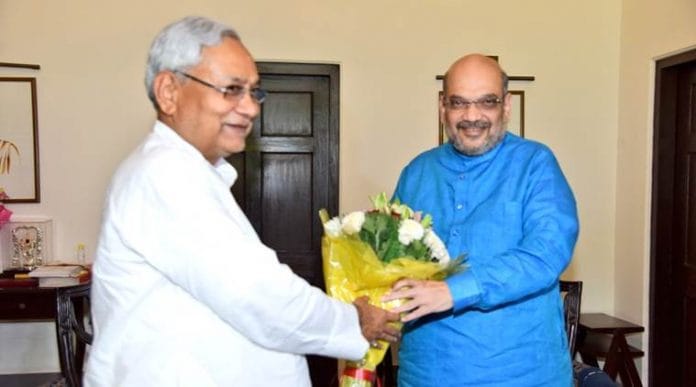Analysis of 2014 Lok Sabha results shows NDA could lose 18 seats in Bihar if Nitish joins hands with Lalu’s grand alliance
New Delhi: Amit Shah meets Bihar chief minister and JD(U) president Nitish Kumar Thursday and there is an apparent urgency in the BJP chief’s desire to work out the seat-sharing between the two parties for the Lok Sabha elections next year.
The JD(U) has been making serious noises about the number of seats it wants to contest in the critical heartland state and the BJP appears to be conscious of the damage Nitish’s party could inflict if it dumps ally BJP and goes back to embrace Lalu Prasad Yadav’s Rashtriya Janata Dal (RJD).
An analysis of the 2014 Lok Sabha elections by ThePrint shows that had the JD(U) allied with the RJD and the Congress, the BJP-led National Democratic Alliance (NDA) would have lost 18 seats in Bihar.
In 2014, the BJP had tied up with the Lok Janshakti Party (LJP) and the Rashtriya Lok Samata Party (RLSP). The alliance nearly swept the state.
Of the 40 Lok Sabha seats in Bihar, the BJP, contesting as the major alliance partner for the first time in 17 years, won 22, the LJP won six seats, while the RLSP secured three – a total of 31 for the alliance.
While getting the LJP and RLSP on board benefited the BJP immensely, there was another significant factor behind the victory — the JD(U) contesting alone.
The spoilsport
The JD(U) performed disastrously in the 2014 elections, managing just two Lok Sabha seats. But its vote share of 16 per cent dented the prospects of the RJD-Congress alliance while helping the BJP’s victory in a number of seats.
In 15 seats, JD(U) candidates secured over one lakh votes. In four of these, the party lost despite securing over 2 lakh votes. Had the JD(U) allied with RJD and the Congress, their combined votes would have ensured the NDA’s defeat in 18 seats.
The BJP has experienced the effect of the JD(U) teaming up with the opposition. In the 2015 assembly elections, when the JD(U) allied with the RJD and the Congress, the BJP was reduced to 55 assembly seats from 91 in the previous election.
The grand alliance formed the government after securing 178 of the total 243 seats in the Bihar assembly. The alliance held power until July 2017, when Nitish broke away to form a government with the BJP.
Senior JD(U) leader K.C, Tyagi says that there is a level of acceptance that his party enjoys across the state. “The good work of Nitish Kumar has reached across sections of Bihar and he has been able to develop a vote bank that is not guided by caste and religion but by the development of the state,” he said. “Anyone who wants the state to grow will choose Nitish and no one else. He has proved it time and again.






